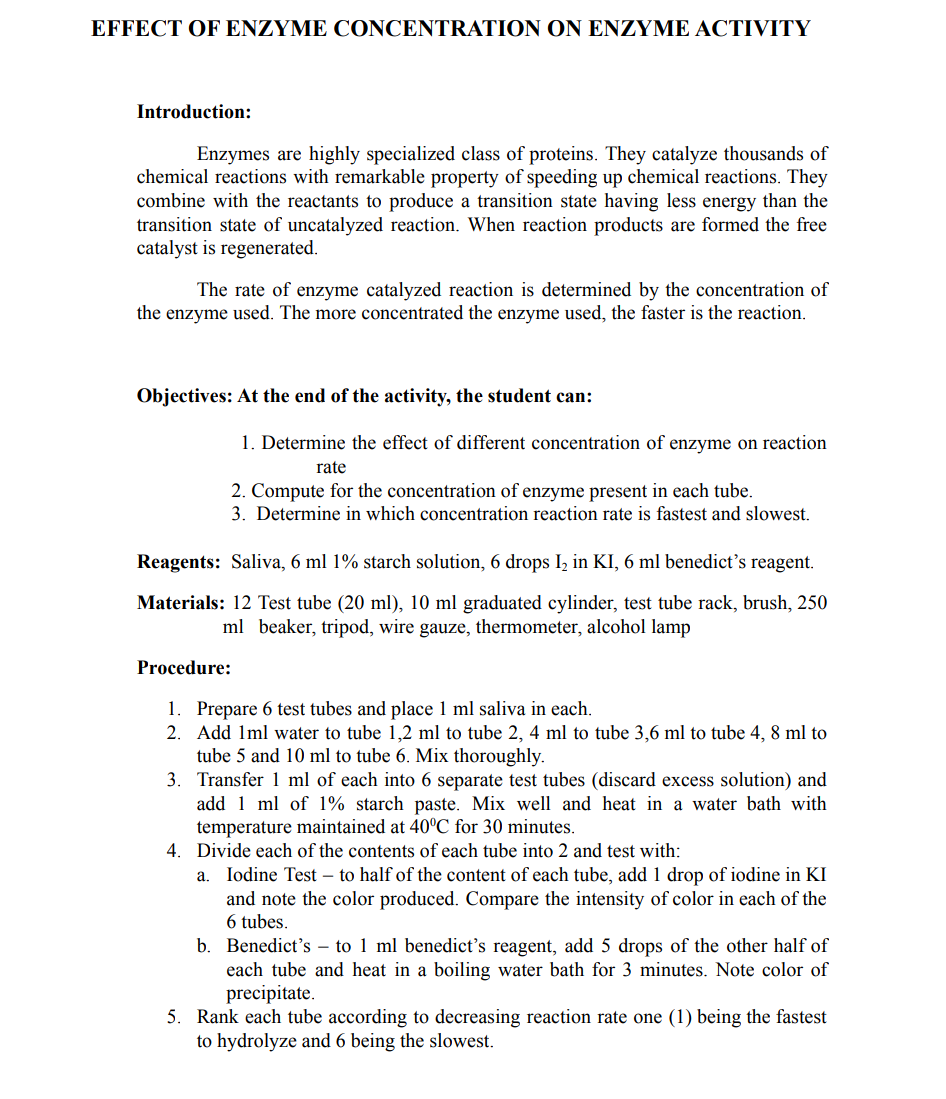What reaction is taking place in the above activity?
Biochemistry
9th Edition
ISBN:9781319114671
Author:Lubert Stryer, Jeremy M. Berg, John L. Tymoczko, Gregory J. Gatto Jr.
Publisher:Lubert Stryer, Jeremy M. Berg, John L. Tymoczko, Gregory J. Gatto Jr.
Chapter1: Biochemistry: An Evolving Science
Section: Chapter Questions
Problem 1P
Related questions
Question
Number 5 please

Transcribed Image Text:5. What reaction is taking place in the above activity?

Transcribed Image Text:EFFECT OF ENΖΥΜΕ CONCENTRATIOΝ ON ΕNZΥΜΕ ACTIVITY
Introduction:
Enzymes are highly specialized class of proteins. They catalyze thousands of
chemical reactions with remarkable property of speeding up chemical reactions. They
combine with the reactants to produce a transition state having less energy than the
transition state of uncatalyzed reaction. When reaction products are formed the free
catalyst is regenerated.
The rate of enzyme catalyzed reaction is determined by the concentration of
the enzyme used. The more concentrated the enzyme used, the faster is the reaction.
Objectives: At the end of the activity, the student can:
1. Determine the effect of different concentration of enzyme on reaction
rate
2. Compute for the concentration of enzyme present in each tube.
3. Determine in which concentration reaction rate is fastest and slowest.
Reagents: Saliva, 6 ml 1% starch solution, 6 drops Iz in KI, 6 ml benedict's reagent.
Materials: 12 Test tube (20 ml), 10 ml graduated cylinder, test tube rack, brush, 250
ml beaker, tripod, wire gauze, thermometer, alcohol lamp
Procedure:
1. Prepare 6 test tubes and place 1 ml saliva in each.
2. Add 1ml water to tube 1,2 ml to tube 2, 4 ml to tube 3,6 ml to tube 4, 8 ml to
tube 5 and 10 ml to tube 6. Mix thoroughly.
3. Transfer 1 ml of each into 6 separate test tubes (discard excess solution) and
add 1 ml of 1% starch paste. Mix well and heat in a water bath with
temperature maintained at 40°C for 30 minutes.
4. Divide each of the contents of each tube into 2 and test with:
a. Iodine Test – to half of the content of each tube, add 1 drop of iodine in KI
and note the color produced. Compare the intensity of color in each of the
6 tubes.
b. Benedict's – to 1 ml benedict's reagent, add 5 drops of the other half of
each tube and heat in a boiling water bath for 3 minutes. Note color of
precipitate.
5. Rank each tube according to decreasing reaction rate one (1) being the fastest
to hydrolyze and 6 being the slowest.
Expert Solution
This question has been solved!
Explore an expertly crafted, step-by-step solution for a thorough understanding of key concepts.
Step by step
Solved in 2 steps with 1 images

Recommended textbooks for you

Biochemistry
Biochemistry
ISBN:
9781319114671
Author:
Lubert Stryer, Jeremy M. Berg, John L. Tymoczko, Gregory J. Gatto Jr.
Publisher:
W. H. Freeman

Lehninger Principles of Biochemistry
Biochemistry
ISBN:
9781464126116
Author:
David L. Nelson, Michael M. Cox
Publisher:
W. H. Freeman

Fundamentals of Biochemistry: Life at the Molecul…
Biochemistry
ISBN:
9781118918401
Author:
Donald Voet, Judith G. Voet, Charlotte W. Pratt
Publisher:
WILEY

Biochemistry
Biochemistry
ISBN:
9781319114671
Author:
Lubert Stryer, Jeremy M. Berg, John L. Tymoczko, Gregory J. Gatto Jr.
Publisher:
W. H. Freeman

Lehninger Principles of Biochemistry
Biochemistry
ISBN:
9781464126116
Author:
David L. Nelson, Michael M. Cox
Publisher:
W. H. Freeman

Fundamentals of Biochemistry: Life at the Molecul…
Biochemistry
ISBN:
9781118918401
Author:
Donald Voet, Judith G. Voet, Charlotte W. Pratt
Publisher:
WILEY

Biochemistry
Biochemistry
ISBN:
9781305961135
Author:
Mary K. Campbell, Shawn O. Farrell, Owen M. McDougal
Publisher:
Cengage Learning

Biochemistry
Biochemistry
ISBN:
9781305577206
Author:
Reginald H. Garrett, Charles M. Grisham
Publisher:
Cengage Learning

Fundamentals of General, Organic, and Biological …
Biochemistry
ISBN:
9780134015187
Author:
John E. McMurry, David S. Ballantine, Carl A. Hoeger, Virginia E. Peterson
Publisher:
PEARSON